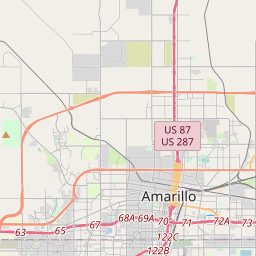Fort Worth and Denver City Railway, First Railroad through the Texas Panhandle
Historical marker location:






Pioneered transportation in the old buffalo and Indian frontier and the open-range cattle empire. Organized by Fort Worth citizens. Although chartered by the Texas Legislature on May 26, 1873, the actual building was delayed by the money panic of 1873.
Under General G.M. Dodge, civil engineer who had built several major lines, grading began in 1881 at Hodge, near Fort Worth. Despite the 1882 repeal of the Texas Land Grant Act, private capital was able to push rails northwestward at intervals. Numerous towns, including Amarillo (in 1887) began as camps of the crews building grade and laying the tracks.
On March 14, 1888, connection was made with rails of the Denver, Texas and Fort Worth Railroad (now Colorado and Southern) at Union Park, near Folsom, N. Mex. This completed the through route to Denver. In 1908 the Fort Worth and Denver City became a part of the Burlington System; in 1951 the name was changed to Fort Worth and Denver Railway Company.
Ever since its beginning, this railroad has been backed by men with unlimited faith in the destiny of the Texas Panhandle. It has advanced the economy based on cattle, grain, petroleum, and manufacturing.
(1966)
As one of the most visible programs of the Texas Historical Commission (THC), historical markers commemorate diverse topics in Texas history, including: the history and architecture of houses, commercial and public buildings, religious congregations, and military sites; events that changed the course of local and state history; and individuals who have made lasting contributions to the state, community organizations, and businesses.
The state flower of Texas is the bluebonnet. The flower blooms in the spring and is a common sight along the highways and in fields throughout the state.
In 1876, Potter County was officially established and named after Robert Potter, a lawyer and signer of the Texas Declaration of Independence. The county's first town, Amarillo, was founded soon after and quickly became the county seat. Initially, Amarillo served as a cattle shipping point and a center for trade, attracting businesses and settlers from surrounding areas.
The early 20th century brought significant development to Potter County. The discovery of oil in nearby areas in the 1920s led to a boom in the county, with oil companies setting up operations and bringing wealth and jobs to the region. This growth and prosperity continued throughout the 20th century, with Amarillo becoming a major economic and cultural hub in the Texas Panhandle.
Today, Potter County continues to thrive as a vibrant community. Its economy is diversified, with significant contributions from industries such as healthcare, education, agriculture, and tourism. The county boasts numerous parks, museums, and attractions, making it an attractive destination for visitors. With its rich history and ongoing growth, Potter County remains a significant contributor to the heritage and economy of Texas.
Potter County Timeline
This timeline provides a condensed summary of the historical journey of Potter County, Texas.
- Potter County is formed on August 21, 1876
- In 1886, Amarillo becomes the county seat of Potter County
- The first courthouse in Potter County is built in 1887
- The first oil well is drilled in Potter County in 1921
- Potter County experiences significant growth during the oil boom of the 1920s
- Palo Duro Canyon State Park is established in Potter County in 1934
- In 1951, the Pantex Plant is established in Potter County, becoming a key facility for the assembly and disassembly of nuclear weapons
- The Tri-State Fair & Rodeo, held annually in Potter County, celebrates its 100th anniversary in 2021